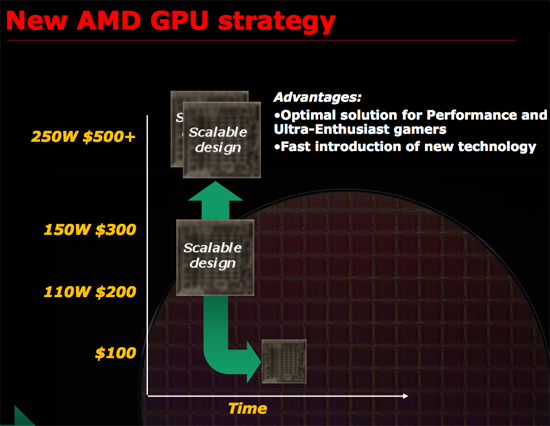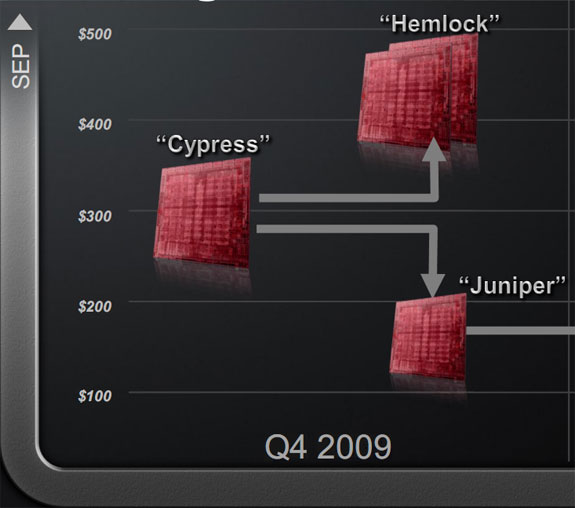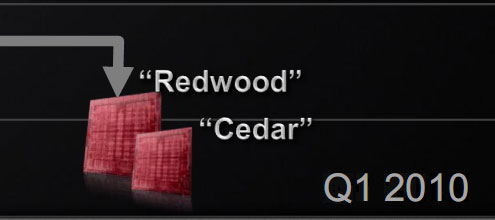AMD's Radeon HD 5870: Bringing About the Next Generation Of GPUs
by Ryan Smith on September 23, 2009 9:00 AM EST- Posted in
- GPUs
Meet the Rest of the Evergreen Family
Somewhere on the way to Cypress, AMD’s small die strategy got slightly off-track.

AMD’s small-die strategy for RV770
Cypress is 334mm2, compared to 260mm2 for RV770. In that space they can pack 2.15 billion transistors, versus 956 million on the RV770, and come out at a load power of 188W versus 160W on the RV770. AMD called 256mm2 their sweet spot for the small die strategy, and Cypress missed that sweet spot.
The cost of missing the sweet spot is that by missing the size, they’re missing the price. The Cypress cards are $379 and $259, compared to $299 and $199 that the original small die strategy dictated. This has resulted in a hole in the Evergreen family, which is why we’re going to see one more member than usual.

As Cypress is the base chip, there are 4 designs and 3 different chips that will be derived from it. Above Cypress is Hemlock, which will be the requisite X2 part using a pair of Cypress cores. Hemlock is going to be interesting to watch not just for its performance, but because by missing their sweet spot, AMD is running a bit hot. A literal pair of 5870s is 376W, which is well over the 300W limit of a 6-pin + 8-pin power configuration. AMD saves some power in a single card (which is how they got the 4870 under the limit) but it likely won’t be enough. We’ll be keeping an eye on this matter to see what AMD ends up doing to get Hemlock out the door at the right power load. As scheduled we should see Hemlock before the end of the year, although given the supply problems for Cypress that we mentioned earlier, it’s going to be close.
The “new” member of the Evergreen family is Juniper, a part born out of the fact that Cypress was too big. Juniper is the part that’s going to let AMD compete in the <$200 category that the 4850 was launched in. It’s going to be a cut-down version of Cypress, and we know from AMD’s simulation testing that it’s going to be a 14 SIMD part. We would wager that it’s going to lose some ROPs too. As AMD does not believe they’re particularly bandwidth limited at this time with GDDR5, we wouldn’t be surprised to see a smaller bus too (perhaps 192bit?). Juniper based cards are expected in the November timeframe.

Finally at the bottom we have Redwood and Cedar, the Evergreen family’s compliments to RV710 and RV730. These will be the low-end parts derived from Cypress, and will launch in Q1 of 2010. All told, AMD will be launching 4 chips in less than 6 months, giving them a top-to-bottom range of DX11 parts. The launch of 4 chips in such a short time frame is something their engineering staff is very proud of.










327 Comments
View All Comments
Agentbolt - Wednesday, September 23, 2009 - link
Informative and well-written. My main question was "how future-proof is it?" I got the Radeon 9700 for DirectX9, the 8800GTS for DirectX10, and it looks like I may very well be picking this up for DirectX11. It's nice there's usually one card you can pick up early that'll run games for years to come at acceptable levels.kumquatsrus - Wednesday, September 23, 2009 - link
great article and great card btw. just wanted to point out that the gtx 285 also had 2x6 pins only required, i believe.Ryan Smith - Wednesday, September 23, 2009 - link
That's correct. I'm not sure how "275" ended up in there.SiliconDoc - Wednesday, September 23, 2009 - link
One wonders how the 8800GT ended up on the Temp/Heat comparison, until you READ the text, and it claims heat is "all over the place", then the very next line is "ALL the Ati's are up @~around 90C" .Yes, so temp is NOT alkl over the place, it's only VERY HIGH for ALL the ATI cards... and NVIDIA cards are not all very high...
-so it becomes CLEAR the 8800GT was included ONLY so the article could whine it was at 92C, since the 275 is @ 75C and the 260 is low the 285 is low, etc., NVidia WINS HANDS DOWN the temperature game...... buit the article just couldn't bring itself to be HONEST about that.
---
What a shame. Deception, the name of the game.
Ryan Smith - Wednesday, September 23, 2009 - link
The 8800GT, as was the 3870, was included to offer a snapshot of an older value product in our comparisons. The 8800GT in particular was a very popular card, and there are still a lot of people out there using them. Including such cards provides a frame of reference for performance for people using such cards.SiliconDoc - Wednesday, September 23, 2009 - link
Gee I cannot imagine load temps for the 4980 and 4870x2 exist anywhere else on this site along with the 260,275, and 285... can you ?Oh, how about I look...
Finally - Wednesday, September 23, 2009 - link
Nvidida-Trolls tend to turn green when feeling inferior.SiliconDoc - Wednesday, September 23, 2009 - link
Turning green was something the 40nm 5870 was supposed to do wasn't it ?Instead it turned into another 3D HEAT MONSTER, like all the ati cards.
Take a look at the power charts, then look at that "wonderful tiny ATI die size that makes em so much money!" (as they lose a billion plus a year), and then calculate that power into that tiny core, NOT minusing failure for framerates hence "less data", since of course ati cards are "faster" right ?
So you've got more power in a smaller footprint core...
HENCE THE 90 DEGREE CELCIUS RUNNING RATES, AND BEYOND.
---
Yeah, so sorry that it's easier for you to call names than think.
RubberJohnny - Wednesday, September 23, 2009 - link
LOL...replying to your own post 3 times...gettin all worked up about temps...PUTTIN STUFF IN CAPS...Looks like this fan boy just can't accept that the 5890 is a great card. Not surprising really, these reviews always seem to bring the fanboys/trolls/whackos out of the woodwork.
Once again, good job AT!!!
JarredWalton - Thursday, September 24, 2009 - link
SiliconDoc, you should try thinking instead of trolling. Why would the maximum be around 90C? Because that's what the cards are designed to target under load. If they get hotter, the fan speeds would ramp up a bit more. There's no need to run fans at high rates to cool down hardware if the hardware functions properly.Reviewing based on max temperatures is a stupid idea when other factors come into play, which is why one page has power draws, temperatures, and noise levels. The GTX 295 has the same temperature not because it's "as hot" but because the fan kicked up to a faster speed to keep that level of heat.
The only thing you can really conclude is that slower GPUs generate less heat and thus don't need to increase fan speeds. The 275 gets hotter than the 285 as well by 10C, but since the 285 is 11.3 dB louder I wouldn't call it better by any stretch. It's just "different".